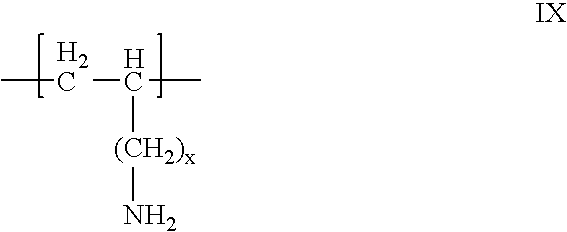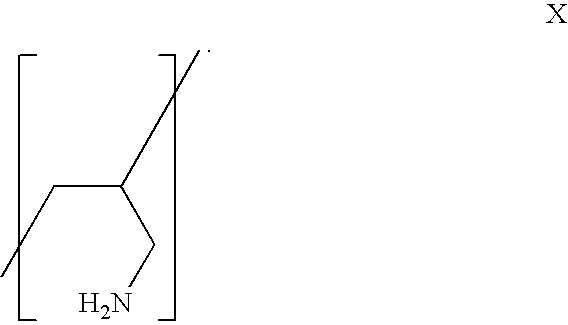Aliphatic amine polymer salts for tableting
a technology of aliphatic amine and polymer salts, which is applied in the field of aliphatic amine polymer salts for tableting, can solve the problems of metabolic acidosis, low blood ph, severe abnormalities in calcium and phosphorus metabolism, etc., and achieve the effect of preventing or ameliorating acidosis
- Summary
- Abstract
- Description
- Claims
- Application Information
AI Technical Summary
Benefits of technology
Problems solved by technology
Method used
Image
Examples
example 1
[0076] Better compactibility and disintegration time of mixed aliphatic amine carbonate salt and monovalent anion formulation as compared to the formulation containing sevelamer carbonate alone.
[0077] The term “physically mixed salt” refers to dry blending of sevelamer HCl and sevelamer carbonate API (2 compounds). The total chloride was targeted to be in the range of 4 to 6%.
[0078] Based on the ratios of sevelamer hydrochloride to sevelamer carbonate used, the % LOD for the final mixture of sevelamer hydrochloride and sevelamer carbonate was calculated. For the wetting of the mixture to target % loss on drying (LOD), the sevelamer hydrochloride API, sevelamer carbonate API and Ceolus® were added directly to the Diosna (a high shear wetting equipment / granulator). The blend was mixed for 3 minutes using the impeller rotating at 435 rpm. Purified water was then added to the blend using a spray bottle to achieve the target LOD in a Diosna Granulator over a 20 minute mixing period. Th...
example 2
[0089] Effect of various ratios of sevelamer HCl to sevelamer carbonate on compactibility, ejection forces and disintegration times.
[0090] The sevelamer hydrochloride to sevelamer carbonate ratios of 1:1, 1:3, 1:6 and 1:9 were evaluated using the excipients used in the Renagel® formulation (800 mg active API, 8% target LOD, 0.375% colloidal silicon dioxide and 0.4% stearic acid) (see Table 2). All experiments were carried out as described above for Example 1
TABLE 2Effect of various ratios of sevelamer HCl tosevelamer carbonate on disintegration times.Formulation: 8% LOD, No Ceolus, 0.375% Colloidalsilicon dioxide (CSD), 0.4% stearic acidDisintegration Time(minutes) of CoreTablets stored atSev.60 C. Performed in pHHCI:Sev.1.2 with disk and screenCO3PCCompactibilityAverageAverageAverageAveragewt. Ratio(kN)CF - (kN)(N / kN)t = 01 week2 weeks3 weeks1 to 1151915.90.81.91.31.31 to 315448.72.52.72.42.41 to 615452.21.7ND0.71.41 to 915452.02.3NDND2.2
ND: Not determined,
PC: Precompression fo...
example 3
Comparison of Physically Mixed Salts with Chemically Mixed Salts
[0092] All experiments were carried out as described above for Example 1. As can be seen from Table 3 the chemically mixed salt also resulted in pharmaceutically acceptable disintegration times.
[0093] The chemically mixed salt were prepared by adding sevelamer hydrochloride to an aqueous solution of sodium carbonate and sodium bicarbonate.
TABLE 3Comparison of physically mixed and chemically mixed saltDisintegration Time(minutes) of CoreTablets stored at60 C. Performed in pH 1.2SevelamerSevelamerwith disk and screen%%LubricanthydrochloridecarbonateHardnessAverageAverageAverageAverageApproachLODCeolusused% Lubricantlot #lot #% Chloride(N)t = 01 week2 weeks3 weeksPhysically10.55PRUN0.52448260241634444881.12.42.83.3mixedChemically10.55PRUN0.5NANA530512.111.311.211.5mixedPhysically10.55Zinc0.52448260241634444881.04.44.95.2mixedstearateChemically10.55Zinc0.5NANA51167.16.766.2mixedstearate
PUM
| Property | Measurement | Unit |
|---|---|---|
| disintegration time | aaaaa | aaaaa |
| diameter | aaaaa | aaaaa |
| disintegration time | aaaaa | aaaaa |
Abstract
Description
Claims
Application Information
 Login to View More
Login to View More - R&D
- Intellectual Property
- Life Sciences
- Materials
- Tech Scout
- Unparalleled Data Quality
- Higher Quality Content
- 60% Fewer Hallucinations
Browse by: Latest US Patents, China's latest patents, Technical Efficacy Thesaurus, Application Domain, Technology Topic, Popular Technical Reports.
© 2025 PatSnap. All rights reserved.Legal|Privacy policy|Modern Slavery Act Transparency Statement|Sitemap|About US| Contact US: help@patsnap.com



